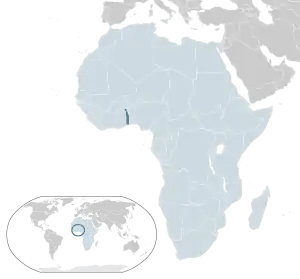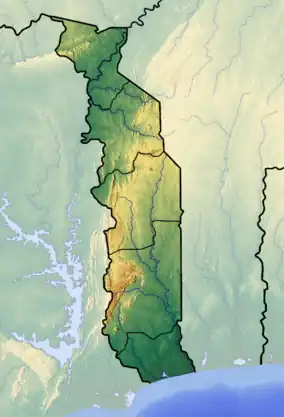1967 Togolese coup d'état
The 1967 Togolese coup d'état was a bloodless military coup that occurred in the West African country of Togo on 13 January 1967.[1] The leader of the coup, Lieutenant Colonel Étienne Eyadéma (later General Gnassingbé Eyadéma) ousted Togo's second President, Nicolas Grunitzky, whom he essentially brought to power following the 1963 coup d'état.
| 1967 Togolese coup d'état | |||||||
|---|---|---|---|---|---|---|---|
 | |||||||
| |||||||
| Belligerents | |||||||
|
|
| ||||||
| Commanders and leaders | |||||||
| Nicolas Grunitzky |
Étienne Eyadéma Kléber Dadjo | ||||||
| Casualties and losses | |||||||
| No casualties reported. | |||||||
 Nexus of coup in Lomé (marked green), Togo | |||||||
Following the coup, political parties were banned, and all constitutional processes were suspended. Colonel Kléber Dadjo was named interim President of Togo (as Chairman of the National Reconciliation Committee), a position that he held until 14 April 1967, when Eyadéma assumed the presidency.[1]
Eyadéma went on to rule the country until his death on 5 February 2005.[2][3][4][5]
References
Notes
- "Coups in Togo". globalsecurity.org. Retrieved 2019-03-10.
- "Gnassingbé Eyadéma, 69, Togo Ruler, Dies". The New York Times. February 7, 2005. Retrieved March 10, 2019.
- "Togolese president Eyadema dies". BBC. February 6, 2005. Retrieved March 10, 2019.
- Wurster 2005, p. 1566.
- Kuranga 2012, p. 74.
Bibliography
- Wurster, Patrick F.A. (2005). "Togo: Eyadema, Gnassingbe, Life and Era of President of Togo". In Kevin Shillington (ed.). Encyclopedia of African History. Taylor & Francis Group. pp. 1566–1568. ISBN 1135456704.
- Kuranga, David Oladipupo (2012). The Power of Interdependence: Lessons from Africa. Palgrave Macmillan. ISBN 978-1-137-01993-6.
This article is issued from Wikipedia. The text is licensed under Creative Commons - Attribution - Sharealike. Additional terms may apply for the media files.